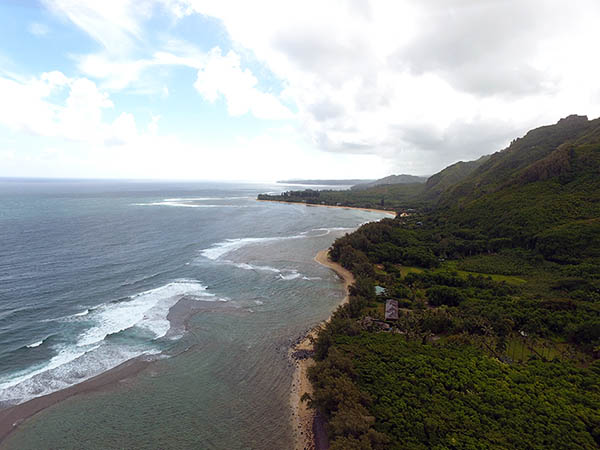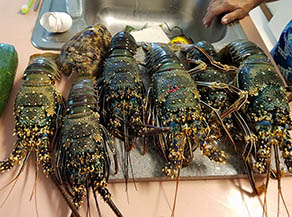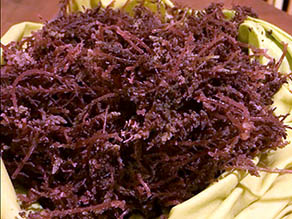 |
 |
 |
 |
||||||
|
|
|
|
|
|
|
|
|
|
 |
 |
 |
“We eat the green ones,” Kelii adds. “The green one you can tell, because there is like a ring, little bit white around them. The spine that comes out, there’s a little white around them. You can eat them.” “For get the wana,” Uncle Tom relates, “we go cut the wire. Might be about four or five feet. So get a long handle, bend them in half then put them in one pipe and twist that thing, and then the ends, you get a fork. And you make one claw at that end. You go get the wana with that, so you no get poked. All improvise. “I learned how to make the wana kind thing, to go box all the thorns off. Chicken wire. You can roll the wana inside there, back and forth, so the thorns get all bust off. Then you go get the wana.” “I wasn’t a big wana eater, Lahela admits. “But we used to get when we have to go maybe get some for eat, if we catch lobster. It’s a delicacy—the raw lobster and the meat you mix with the wana. My family loved that, but I wasn’t big on it. I’d eat some, I eat more fish than that, but I know how to go and gather. Right in front where Chipper guys, Paliaka, as you’re coming here there’s that reef come all the way out, you can actually walk outside, that’s where the wana is, and you can get some. I used to, when I ono, I just go up and go walk out with the kids and take them and then clean one outside there. I think that’s what they’re trying to also bring back right now. I think there’s so much you only can get maybe four or something like that, per person.” Ula and Kūhonu: “We did lobster catching, Lahela continues. “My brother guys was incredible, they taught us how to get lobster. I wasn’t the one to grab it. They used to dive in the holes and I used to hold the bag open. I didn’t eat them raw until I was a little older, not in my high school, even when I came out of school. “My father used to make it, and I’m like 'What is this?' Maybe before, even maybe it was 1989, I had learned how for eat that. And it’s just by salting: the amount of salt that you put on top and you let it sit. You got to cut in half with a knife and open, butterfly that thing, and you put all in the head and all in the tail, and you let them sit for a couple of days inside the fridge, can even stay in a week—the longer the better. And you can see it will end up turning kind of black, black inky on top. That’s when you want to eat them. “I learned from my father. Without him I would have never eaten raw like that. When us was young, they used to mix it with the wana. I never eat it like that, but raw. So there is only a few, my oldest daughter loves it like that, when we can catch. It’s been a long time we haven’t eaten, maybe at least a year or so. But more common when we were young. We would see my father making it.” “And we set crab nets,” Nalani points out. “The kuhono crab.” Limu: “We also got limu kohu,” Kelii says. “We get limu kala, we have limu epe‘e—it’s small, you got to really look good for that seaweed. It looks like a little coral, and it’s only certain places that have it here. But very good eating.” “We get limu kohu, get all kine limu over here, get plenty stuff, “Uncle Tom confirms. “We put them in the soup. Like the limu, you can put them in your stew. Or you can put them in your raw fish, like lomi. Most time like akule.” Shell Fish: “We also get haukeuke, pipi‘i, kupe‘e, all the shell fish,” Kelii adds. “Pipi‘i, you boil them. My grandmother boiled them. She would put garlic inside and then boil them. Then you see, it’s like a little hi‘iwae. But hi‘iwae has a shell—it’s a halfway shell. When you boil it, it pops open. So when this opens up, you know it’s cooked. When you get a little needle and you go inside and you poke it out with the needle. And you eat it. We used to love that as kids growing up. We eat them all the time. My grandmother go get pipi‘i for me." “‘Opihi, my brothers used to always take us and when we were young,” Lahela says. We’re older now, we cannot be as sturdy on the rocks as we used to. But family still goes when we can. We were raised on opihi too. When I had my first child I was so hungry for that. ‘Opihi Kepuhi, right here at the point where the river is, where you cross along the iron bridge. As you come this way you see that small beach. Right down below is the black rocks. I just go down, pregnant, sit on the rock and I tell me husband 'Go. Get me some. Just for me to eat some.' I would sit down, eat. 'Oh, I feel good now.' Then we go home. It is funny when I think about it. But oh my gosh, I was craving it." “Some people think, ‘the bigger the ‘opihi, the better’,” Presley explains. “But you’re better off leaving the big ones alone. You’re better off taking the smaller ones than you are picking the really big ones. The big ones produce way more eggs, I mean thousands of times more than immature. Same thing with some of the fish: everything is geared for the bigger the fish. But you’re better off letting the bigger moi go, it produces way more eggs. Hundreds times more than an immature female. So you’re better off catching the smaller ones, which I’d rather catch anyway and I’d rather eat the smaller ‘opihi than taking the big ones.”
|
 |
|||
 |
Fishing on and beyond the reef was an essential part of life at Hā‘ena. More about fishing is discussed in the next page.
|
 |
||
 |
|
 |
||

|
|
||||
| Copyright 2018 Pacific Worlds & Associates • Usage Policy • Webmaster |
||||








